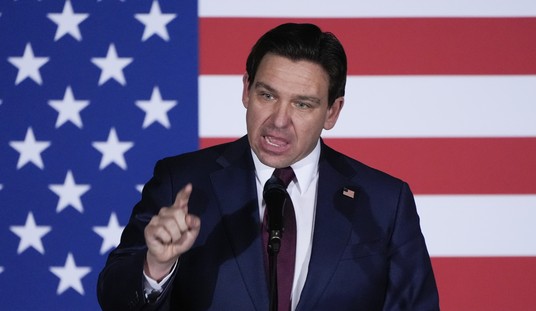Yesterday’s horrific and senseless shooting of more than a dozen people in Tucson, including Representative Gabrielle Giffords, provided a look into the biases of much of the American media — and it was not just an ugly sight, but a shamefully hypocritical peek as well, as Byron York points out. In the last public mass-murder shooting fourteen months ago at Fort Hood, the media spent the first few hours scolding anyone who suggested that it might be an act of terror or that Major Nidal Hasan’s religious beliefs might be relevant before every last fact was exposed:
“The important thing is for everyone not to jump to conclusions,” said retired Gen. Wesley Clark on CNN the night of the shootings.
“We cannot jump to conclusions,” said CNN’s Jane Velez-Mitchell that same evening. “We have to make sure that we do not jump to any conclusions whatsoever.”
“I’m on Pentagon chat room,” said former CIA operative Robert Baer on CNN, also the night of the shooting. “Right now, there’s messages going back and forth, saying do not jump to the conclusion this had anything to do with Islam.”
The next day, President Obama underscored the rapidly-forming conventional wisdom when he told the country, “I would caution against jumping to conclusions until we have all the facts.” In the days that followed, CNN jouralists and guests repeatedly echoed the president’s remarks.
“We can’t jump to conclusions,” Army Gen. George Casey said on CNN November 8. The next day, political analyst Mark Halperin urged a “transparent” investigation into the shootings “so the American people don’t jump to conclusions.” And when Republican Rep. Pete Hoekstra, then the ranking member of the House Intelligence Committee, suggested that the Ft. Hood attack was terrorism, CNN’s John Roberts was quick to intervene. “Now, President Obama has asked people to be very cautious here and to not jump to conclusions,” Roberts said to Hoekstra. “By saying that you believe this is an act of terror, are you jumping to a conclusion?”
That, in fact, was good advice at the time. In most of these cases, the shooter turns out to be so mentally ill that no particular rational motivation can be determined. In the rare case where one can be found, rushing to that conclusion doesn’t make it any more or less true. There is almost no upside in rushing to speculate in absence of any evidence or with uncertain anecdotal evidence except for potential bragging rights in case one manages to luck into the truth — or in scoring cheap attacks on political opponents through smearing them with blame.
But in this instance, as York notes, the same people who insisted in November 2009 that people should not rush to judgment about the potential connection of radical Islam to the Fort Hood shooting practically broke legs trying to tie an apparent paranoid schizophrenic who hailed Mein Kampf and The Communist Manifesto to Sarah Palin:
After reporting that Pima County Sheriff Clarence Dupnik had condemned what Dupnik called “the vitriol that comes out of certain mouths about tearing down the government,” CNN’s Wolf Blitzer turned to congressional reporter Jessica Yellin for analysis. The sheriff “singled out some of the political rhetoric, as you point out, in creating the environment that allowed this kind of instance to happen,” Yellin told Blitzer. “Even though, as you point out, this suspect is not cooperating with investigators, so we don’t know the motive. President Obama also delivered that message, saying it’s partly the political rhetoric that led to this. So that’s why we want to bring up one of the themes that’s burning up the social media right now. On Twitter and Facebook, there is a lot of talk, in particular, about Sarah Palin. As you might recall, back in March of last year, when the health care vote was coming to the floor of the House and this was all heating up, Palin tweeted out a message on Twitter saying ‘common sense conservatives, don’t retreat — instead reload.’ And she referred folks to her Facebook page. On that Facebook page was a list of Democratic members she was putting in crosshairs, and Gabrielle Giffords was one of those in the crosshairs.”
And as has been repeatedly pointed out in the hours since, Democrats have also used crosshairs and bulls-eye imagery in their own political communications, including one in Arizona “targeting” J. D Hayworth of Arizona. As far as the “reload” comment, it was less than three years ago that Barack Obama himself talked about responding to political opponents with a gun analogy:
Mobster wisdom tells us never to bring a knife to a gun fight. But what does political wisdom say about bringing a gun to a knife fight?
That’s exactly what Barack Obama said he would do to counter Republican attacks “If they bring a knife to the fight, we bring a gun,” Obama said at a Philadelphia fundraiser Friday night. “Because from what I understand folks in Philly like a good brawl. I’ve seen Eagles fans.”
The comment drew some laughs and applause. But it also struck a chord with his Republican rival. John McCain’s campaign immediately accused the Democratic candidate of playing the politics of fear. They also mentioned that Obama said he would use a gun that would be illegal under Obama’s plans to cut down on illegal firearms.
Getting hysterical about the use of war terminology in politics is about as hypocritical as one can possibly get, as Howard Kurtz explained yesterday, especially for journalists covering politics:
But is it now fair for the rest of us to tie Palin to the accused gunman, Jared Lee Loughner?
Let’s be honest: Journalists often use military terminology in describing campaigns. We talk about the air war, the bombshells, targeting politicians, knocking them off, candidates returning fire or being out of ammunition. So we shouldn’t act shocked when politicians do the same thing. Obviously, Palin should have used dots or asterisks on her map. But does anyone seriously believe she was trying to incite violence?
Palin seemed to pull back in a subsequent campaign appearance for her former running mate, John McCain. “We know violence isn’t the answer,” she said. “When we take up our arms, we’re talking about our vote.”
It was the Clinton campaign that popularized the term “war room” for the rapid-response team they formed in 1992. Should we blame Clinton for all subsequent wars, too? CNN calls its political-news show the “Situation Room,” after the actual national-security response facility in the White House. Maybe we should blame CNN for inciting wars and violence, too, using their logic?
Getting back to York’s litany of examples, CNN clearly didn’t inadvertently cross the line once, but repeatedly kept insisting on a link between the shooting and political activism on the Right, especially Palin’s:
“But the question is, is there any evidence that the suspected shooter in this particular case was a Sarah Palin fan, read Sarah Palin’s website, was a member on Facebook, watched her tweets, or anything like that?” [Wolf Blitzer asked.]
“None at all,” Yellin responded. “And there is no evidence that this was even inspired by rage over health care, broadly. So there is no overt connection between Sarah Palin, health care, and the [shootings].”
Indeed, there is no “overt” or any other sort of connection between Loughner and Palin. If such evidence came to light, it would certainly be news. But without that evidence, and after a brief caveat, the CNN group went back to discussing the theory that Loughner acted out of rage inspired by Palin and other Republicans. Conclusions were jumped to all around.
Not just on CNN, either, but CNN holds itself out as an unbiased, middle-road news source that people of all political stripes can trust. Instead, they demonstrated their hostility by taking shots at the Right and Palin through the exploitation of a tragedy and horror that no one understood and for which no evidence existed to suggest any link at all. We expect that on Twitter, where people on both sides of the political divide wrote things they will (or should) regret later. CNN owes everyone an apology for their nasty, hysterical, and biased coverage in the aftermath of the shooting yesterday, perhaps especially Sarah Palin.
The rest of us need to focus our attention on continued prayers and support for the victims of the shooting, the families of the deceased, and for the recovery of the rest, especially Representative Gabrielle Giffords, who got shot doing the public service entrusted to her by her constituents.
Update: Contra David Frum, I don’t see this as a particular moment to reflect on “extreme political rhetoric,” since there’s nothing to connect political rhetoric from either side of the political spectrum to this crime. I wouldn’t even call for reflection on the continued sales of Mein Kampf or The Communist Manifesto, even though the suspect credits both of these as among his favorites, as they have no causal connection to the actions of a lunatic. Perhaps, though, this is a good moment to reflect on those who rush to exploit tragedy in an attempt to bully political activists into silence.
The time to criticize “extreme political rhetoric” is when it occurs, and making sure that the people making the accusations aren’t just as culpable as those they attempt to indict.








Join the conversation as a VIP Member